Level 3 Education & Training: Understanding Assessment Principles
VerifiedAdded on 2023/06/18
|19
|7469
|218
Homework Assignment
AI Summary
This assignment provides a comprehensive overview of assessment principles and practices within the context of the Level 3 Award in Education and Training (RQF). It delves into the function of assessment in learning and development, defining key concepts and principles such as initial assessment, assessment planning, activity, decision-making, feedback, and progress review. The assignment outlines the responsibilities of an assessor, including planning, assessing, providing feedback, and maintaining accurate records, while also identifying relevant regulations and requirements in specific areas of practice, such as the beauty industry, emphasizing compliance with health and safety, data protection, and substance use regulations. Furthermore, it compares the strengths and limitations of various assessment methods, such as teacher questions, portfolios, and exams, considering the needs of individual learners. The assignment also summarizes key factors to consider when planning assessments, including validity, reliability, sufficiency, and authenticity, and evaluates the benefits of using a holistic approach to assessment, explaining how to plan for it by catering to individual learning styles and offering a supportive learning environment.
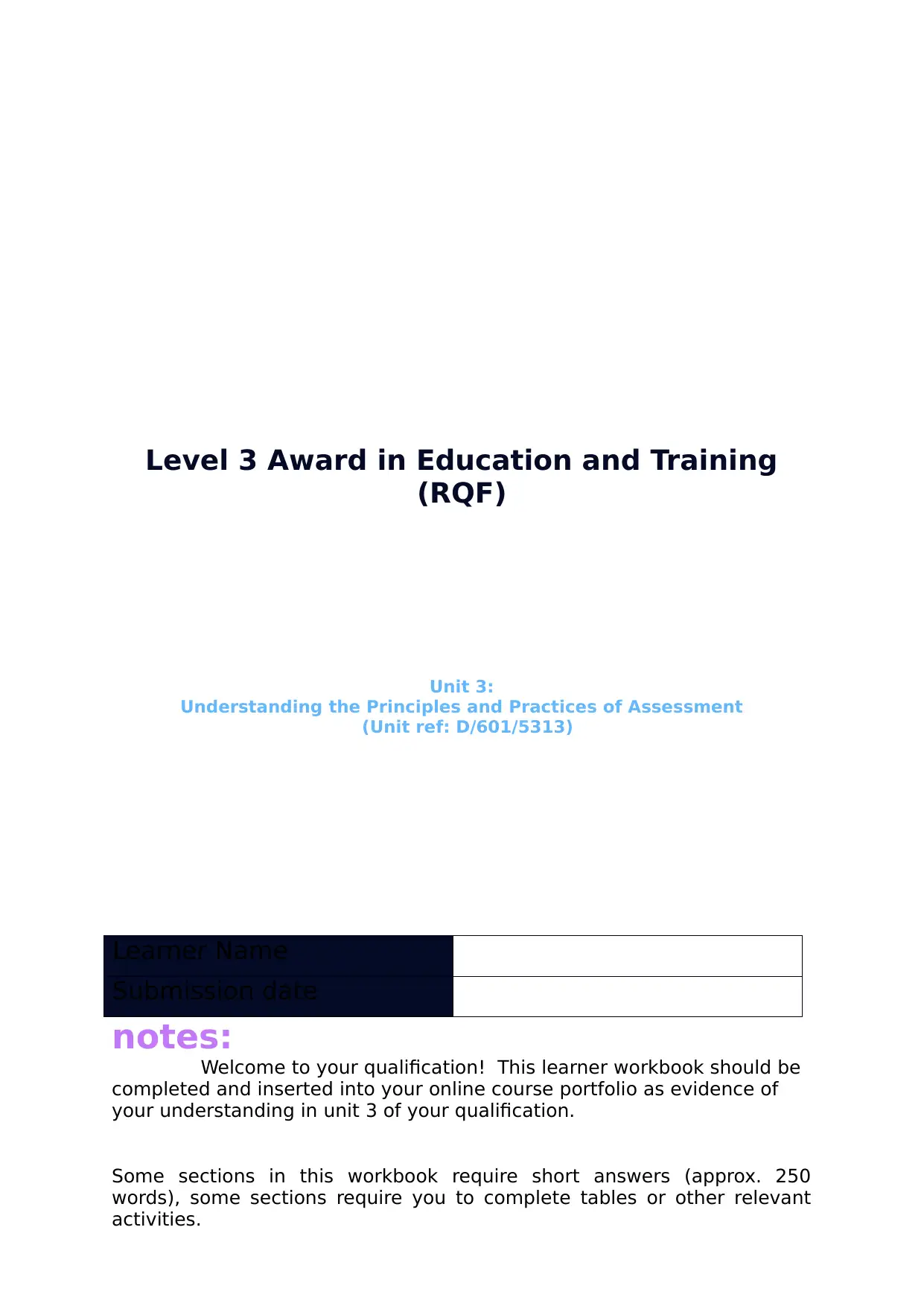
Level 3 Award in Education and Training
(RQF)
Unit 3:
Understanding the Principles and Practices of Assessment
(Unit ref: D/601/5313)
Learner Name
Submission date
notes:
Welcome to your qualification! This learner workbook should be
completed and inserted into your online course portfolio as evidence of
your understanding in unit 3 of your qualification.
Some sections in this workbook require short answers (approx. 250
words), some sections require you to complete tables or other relevant
activities.
(RQF)
Unit 3:
Understanding the Principles and Practices of Assessment
(Unit ref: D/601/5313)
Learner Name
Submission date
notes:
Welcome to your qualification! This learner workbook should be
completed and inserted into your online course portfolio as evidence of
your understanding in unit 3 of your qualification.
Some sections in this workbook require short answers (approx. 250
words), some sections require you to complete tables or other relevant
activities.
Paraphrase This Document
Need a fresh take? Get an instant paraphrase of this document with our AI Paraphraser
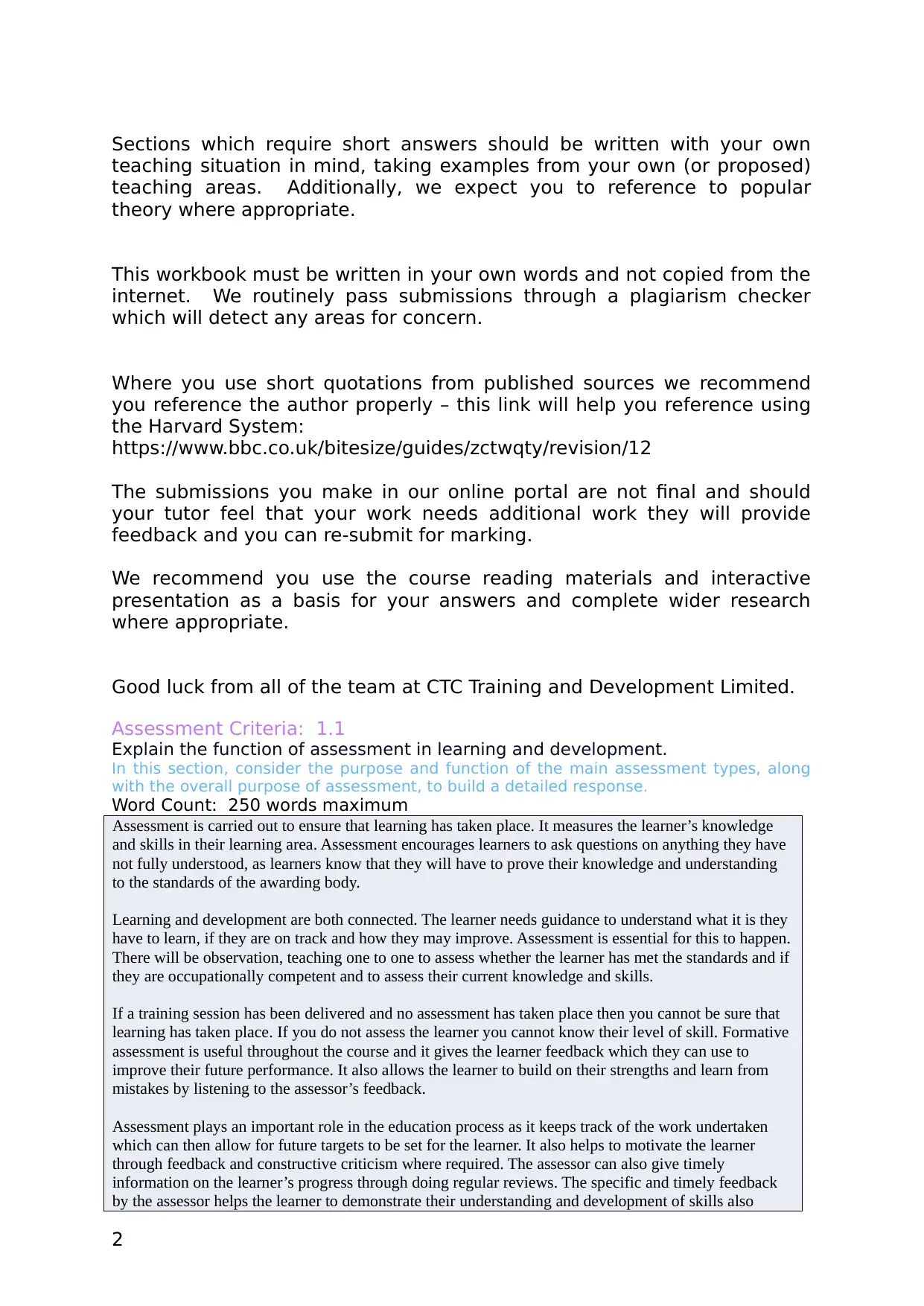
Sections which require short answers should be written with your own
teaching situation in mind, taking examples from your own (or proposed)
teaching areas. Additionally, we expect you to reference to popular
theory where appropriate.
This workbook must be written in your own words and not copied from the
internet. We routinely pass submissions through a plagiarism checker
which will detect any areas for concern.
Where you use short quotations from published sources we recommend
you reference the author properly – this link will help you reference using
the Harvard System:
https://www.bbc.co.uk/bitesize/guides/zctwqty/revision/12
The submissions you make in our online portal are not final and should
your tutor feel that your work needs additional work they will provide
feedback and you can re-submit for marking.
We recommend you use the course reading materials and interactive
presentation as a basis for your answers and complete wider research
where appropriate.
Good luck from all of the team at CTC Training and Development Limited.
Assessment Criteria: 1.1
Explain the function of assessment in learning and development.
In this section, consider the purpose and function of the main assessment types, along
with the overall purpose of assessment, to build a detailed response.
Word Count: 250 words maximum
Assessment is carried out to ensure that learning has taken place. It measures the learner’s knowledge
and skills in their learning area. Assessment encourages learners to ask questions on anything they have
not fully understood, as learners know that they will have to prove their knowledge and understanding
to the standards of the awarding body.
Learning and development are both connected. The learner needs guidance to understand what it is they
have to learn, if they are on track and how they may improve. Assessment is essential for this to happen.
There will be observation, teaching one to one to assess whether the learner has met the standards and if
they are occupationally competent and to assess their current knowledge and skills.
If a training session has been delivered and no assessment has taken place then you cannot be sure that
learning has taken place. If you do not assess the learner you cannot know their level of skill. Formative
assessment is useful throughout the course and it gives the learner feedback which they can use to
improve their future performance. It also allows the learner to build on their strengths and learn from
mistakes by listening to the assessor’s feedback.
Assessment plays an important role in the education process as it keeps track of the work undertaken
which can then allow for future targets to be set for the learner. It also helps to motivate the learner
through feedback and constructive criticism where required. The assessor can also give timely
information on the learner’s progress through doing regular reviews. The specific and timely feedback
by the assessor helps the learner to demonstrate their understanding and development of skills also
2
teaching situation in mind, taking examples from your own (or proposed)
teaching areas. Additionally, we expect you to reference to popular
theory where appropriate.
This workbook must be written in your own words and not copied from the
internet. We routinely pass submissions through a plagiarism checker
which will detect any areas for concern.
Where you use short quotations from published sources we recommend
you reference the author properly – this link will help you reference using
the Harvard System:
https://www.bbc.co.uk/bitesize/guides/zctwqty/revision/12
The submissions you make in our online portal are not final and should
your tutor feel that your work needs additional work they will provide
feedback and you can re-submit for marking.
We recommend you use the course reading materials and interactive
presentation as a basis for your answers and complete wider research
where appropriate.
Good luck from all of the team at CTC Training and Development Limited.
Assessment Criteria: 1.1
Explain the function of assessment in learning and development.
In this section, consider the purpose and function of the main assessment types, along
with the overall purpose of assessment, to build a detailed response.
Word Count: 250 words maximum
Assessment is carried out to ensure that learning has taken place. It measures the learner’s knowledge
and skills in their learning area. Assessment encourages learners to ask questions on anything they have
not fully understood, as learners know that they will have to prove their knowledge and understanding
to the standards of the awarding body.
Learning and development are both connected. The learner needs guidance to understand what it is they
have to learn, if they are on track and how they may improve. Assessment is essential for this to happen.
There will be observation, teaching one to one to assess whether the learner has met the standards and if
they are occupationally competent and to assess their current knowledge and skills.
If a training session has been delivered and no assessment has taken place then you cannot be sure that
learning has taken place. If you do not assess the learner you cannot know their level of skill. Formative
assessment is useful throughout the course and it gives the learner feedback which they can use to
improve their future performance. It also allows the learner to build on their strengths and learn from
mistakes by listening to the assessor’s feedback.
Assessment plays an important role in the education process as it keeps track of the work undertaken
which can then allow for future targets to be set for the learner. It also helps to motivate the learner
through feedback and constructive criticism where required. The assessor can also give timely
information on the learner’s progress through doing regular reviews. The specific and timely feedback
by the assessor helps the learner to demonstrate their understanding and development of skills also
2
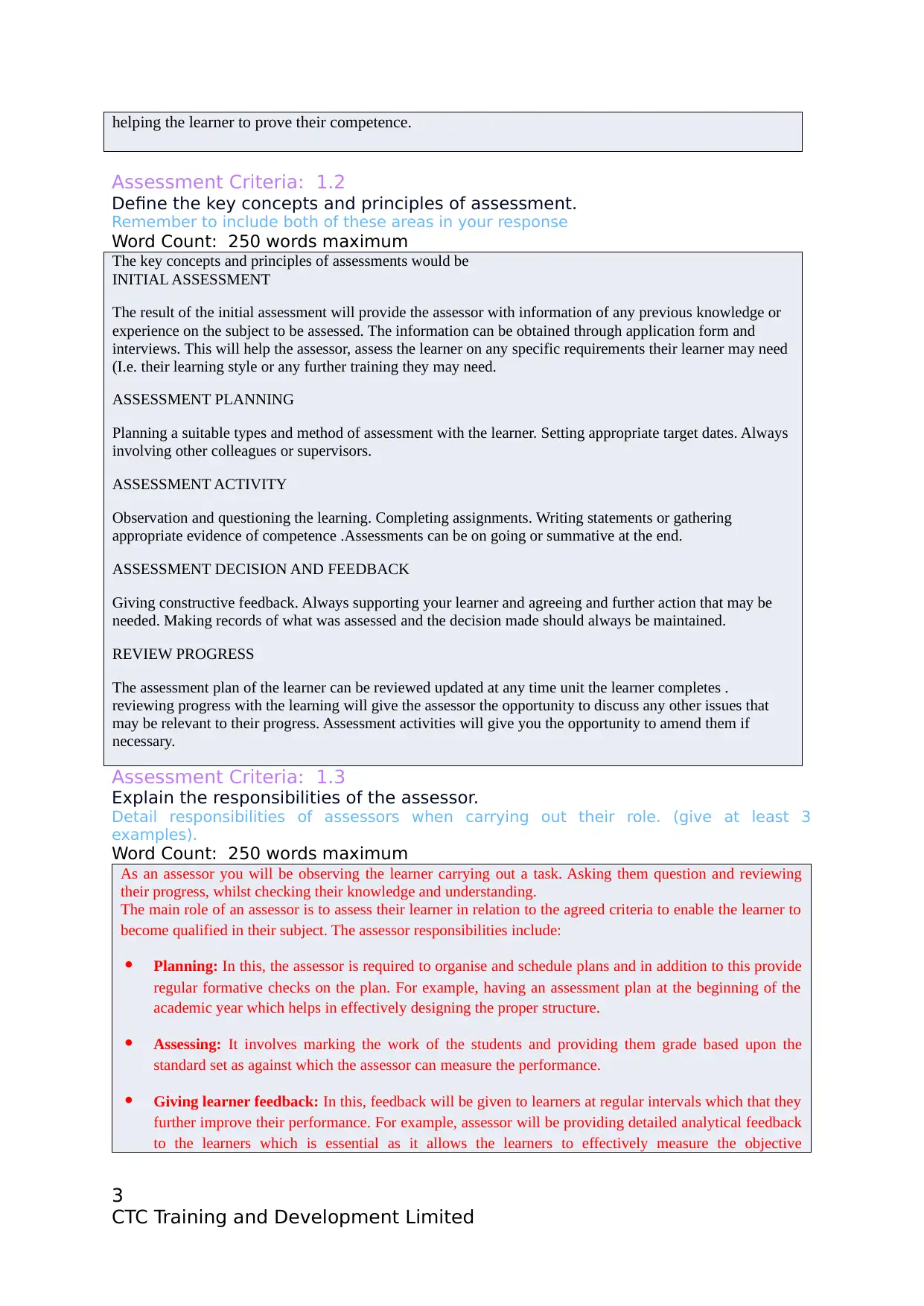
helping the learner to prove their competence.
Assessment Criteria: 1.2
Define the key concepts and principles of assessment.
Remember to include both of these areas in your response
Word Count: 250 words maximum
The key concepts and principles of assessments would be
INITIAL ASSESSMENT
The result of the initial assessment will provide the assessor with information of any previous knowledge or
experience on the subject to be assessed. The information can be obtained through application form and
interviews. This will help the assessor, assess the learner on any specific requirements their learner may need
(I.e. their learning style or any further training they may need.
ASSESSMENT PLANNING
Planning a suitable types and method of assessment with the learner. Setting appropriate target dates. Always
involving other colleagues or supervisors.
ASSESSMENT ACTIVITY
Observation and questioning the learning. Completing assignments. Writing statements or gathering
appropriate evidence of competence .Assessments can be on going or summative at the end.
ASSESSMENT DECISION AND FEEDBACK
Giving constructive feedback. Always supporting your learner and agreeing and further action that may be
needed. Making records of what was assessed and the decision made should always be maintained.
REVIEW PROGRESS
The assessment plan of the learner can be reviewed updated at any time unit the learner completes .
reviewing progress with the learning will give the assessor the opportunity to discuss any other issues that
may be relevant to their progress. Assessment activities will give you the opportunity to amend them if
necessary.
Assessment Criteria: 1.3
Explain the responsibilities of the assessor.
Detail responsibilities of assessors when carrying out their role. (give at least 3
examples).
Word Count: 250 words maximum
As an assessor you will be observing the learner carrying out a task. Asking them question and reviewing
their progress, whilst checking their knowledge and understanding.
The main role of an assessor is to assess their learner in relation to the agreed criteria to enable the learner to
become qualified in their subject. The assessor responsibilities include:
Planning: In this, the assessor is required to organise and schedule plans and in addition to this provide
regular formative checks on the plan. For example, having an assessment plan at the beginning of the
academic year which helps in effectively designing the proper structure.
Assessing: It involves marking the work of the students and providing them grade based upon the
standard set as against which the assessor can measure the performance.
Giving learner feedback: In this, feedback will be given to learners at regular intervals which that they
further improve their performance. For example, assessor will be providing detailed analytical feedback
to the learners which is essential as it allows the learners to effectively measure the objective
3
CTC Training and Development Limited
Assessment Criteria: 1.2
Define the key concepts and principles of assessment.
Remember to include both of these areas in your response
Word Count: 250 words maximum
The key concepts and principles of assessments would be
INITIAL ASSESSMENT
The result of the initial assessment will provide the assessor with information of any previous knowledge or
experience on the subject to be assessed. The information can be obtained through application form and
interviews. This will help the assessor, assess the learner on any specific requirements their learner may need
(I.e. their learning style or any further training they may need.
ASSESSMENT PLANNING
Planning a suitable types and method of assessment with the learner. Setting appropriate target dates. Always
involving other colleagues or supervisors.
ASSESSMENT ACTIVITY
Observation and questioning the learning. Completing assignments. Writing statements or gathering
appropriate evidence of competence .Assessments can be on going or summative at the end.
ASSESSMENT DECISION AND FEEDBACK
Giving constructive feedback. Always supporting your learner and agreeing and further action that may be
needed. Making records of what was assessed and the decision made should always be maintained.
REVIEW PROGRESS
The assessment plan of the learner can be reviewed updated at any time unit the learner completes .
reviewing progress with the learning will give the assessor the opportunity to discuss any other issues that
may be relevant to their progress. Assessment activities will give you the opportunity to amend them if
necessary.
Assessment Criteria: 1.3
Explain the responsibilities of the assessor.
Detail responsibilities of assessors when carrying out their role. (give at least 3
examples).
Word Count: 250 words maximum
As an assessor you will be observing the learner carrying out a task. Asking them question and reviewing
their progress, whilst checking their knowledge and understanding.
The main role of an assessor is to assess their learner in relation to the agreed criteria to enable the learner to
become qualified in their subject. The assessor responsibilities include:
Planning: In this, the assessor is required to organise and schedule plans and in addition to this provide
regular formative checks on the plan. For example, having an assessment plan at the beginning of the
academic year which helps in effectively designing the proper structure.
Assessing: It involves marking the work of the students and providing them grade based upon the
standard set as against which the assessor can measure the performance.
Giving learner feedback: In this, feedback will be given to learners at regular intervals which that they
further improve their performance. For example, assessor will be providing detailed analytical feedback
to the learners which is essential as it allows the learners to effectively measure the objective
3
CTC Training and Development Limited
⊘ This is a preview!⊘
Do you want full access?
Subscribe today to unlock all pages.

Trusted by 1+ million students worldwide
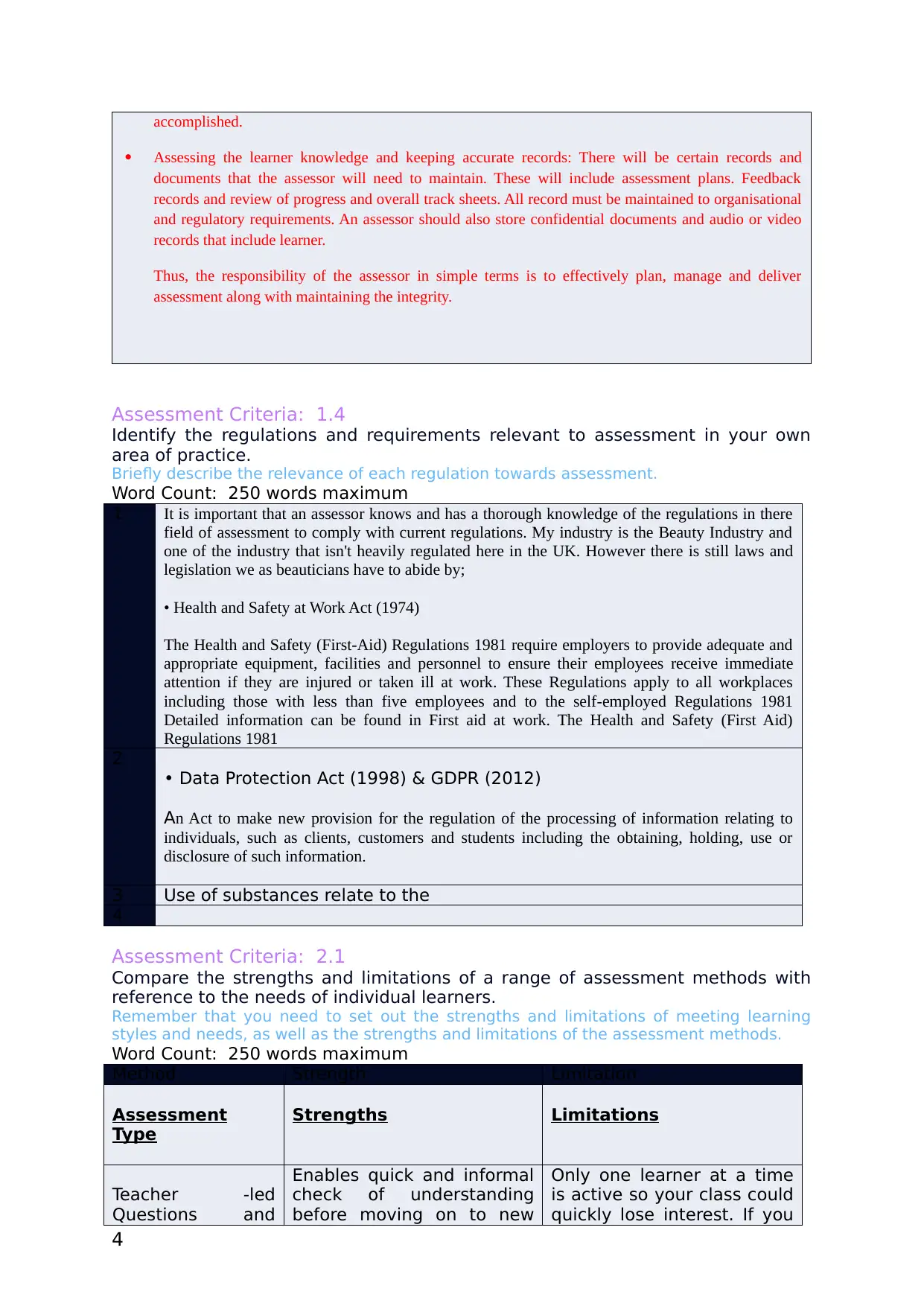
accomplished.
Assessing the learner knowledge and keeping accurate records: There will be certain records and
documents that the assessor will need to maintain. These will include assessment plans. Feedback
records and review of progress and overall track sheets. All record must be maintained to organisational
and regulatory requirements. An assessor should also store confidential documents and audio or video
records that include learner.
Thus, the responsibility of the assessor in simple terms is to effectively plan, manage and deliver
assessment along with maintaining the integrity.
Assessment Criteria: 1.4
Identify the regulations and requirements relevant to assessment in your own
area of practice.
Briefly describe the relevance of each regulation towards assessment.
Word Count: 250 words maximum
1 It is important that an assessor knows and has a thorough knowledge of the regulations in there
field of assessment to comply with current regulations. My industry is the Beauty Industry and
one of the industry that isn't heavily regulated here in the UK. However there is still laws and
legislation we as beauticians have to abide by;
• Health and Safety at Work Act (1974)
The Health and Safety (First-Aid) Regulations 1981 require employers to provide adequate and
appropriate equipment, facilities and personnel to ensure their employees receive immediate
attention if they are injured or taken ill at work. These Regulations apply to all workplaces
including those with less than five employees and to the self-employed Regulations 1981
Detailed information can be found in First aid at work. The Health and Safety (First Aid)
Regulations 1981
2
• Data Protection Act (1998) & GDPR (2012)
An Act to make new provision for the regulation of the processing of information relating to
individuals, such as clients, customers and students including the obtaining, holding, use or
disclosure of such information.
3 Use of substances relate to the
4
Assessment Criteria: 2.1
Compare the strengths and limitations of a range of assessment methods with
reference to the needs of individual learners.
Remember that you need to set out the strengths and limitations of meeting learning
styles and needs, as well as the strengths and limitations of the assessment methods.
Word Count: 250 words maximum
Method Strength Limitation
Assessment
Type
Strengths Limitations
Teacher -led
Questions and
Enables quick and informal
check of understanding
before moving on to new
Only one learner at a time
is active so your class could
quickly lose interest. If you
4
Assessing the learner knowledge and keeping accurate records: There will be certain records and
documents that the assessor will need to maintain. These will include assessment plans. Feedback
records and review of progress and overall track sheets. All record must be maintained to organisational
and regulatory requirements. An assessor should also store confidential documents and audio or video
records that include learner.
Thus, the responsibility of the assessor in simple terms is to effectively plan, manage and deliver
assessment along with maintaining the integrity.
Assessment Criteria: 1.4
Identify the regulations and requirements relevant to assessment in your own
area of practice.
Briefly describe the relevance of each regulation towards assessment.
Word Count: 250 words maximum
1 It is important that an assessor knows and has a thorough knowledge of the regulations in there
field of assessment to comply with current regulations. My industry is the Beauty Industry and
one of the industry that isn't heavily regulated here in the UK. However there is still laws and
legislation we as beauticians have to abide by;
• Health and Safety at Work Act (1974)
The Health and Safety (First-Aid) Regulations 1981 require employers to provide adequate and
appropriate equipment, facilities and personnel to ensure their employees receive immediate
attention if they are injured or taken ill at work. These Regulations apply to all workplaces
including those with less than five employees and to the self-employed Regulations 1981
Detailed information can be found in First aid at work. The Health and Safety (First Aid)
Regulations 1981
2
• Data Protection Act (1998) & GDPR (2012)
An Act to make new provision for the regulation of the processing of information relating to
individuals, such as clients, customers and students including the obtaining, holding, use or
disclosure of such information.
3 Use of substances relate to the
4
Assessment Criteria: 2.1
Compare the strengths and limitations of a range of assessment methods with
reference to the needs of individual learners.
Remember that you need to set out the strengths and limitations of meeting learning
styles and needs, as well as the strengths and limitations of the assessment methods.
Word Count: 250 words maximum
Method Strength Limitation
Assessment
Type
Strengths Limitations
Teacher -led
Questions and
Enables quick and informal
check of understanding
before moving on to new
Only one learner at a time
is active so your class could
quickly lose interest. If you
4
Paraphrase This Document
Need a fresh take? Get an instant paraphrase of this document with our AI Paraphraser
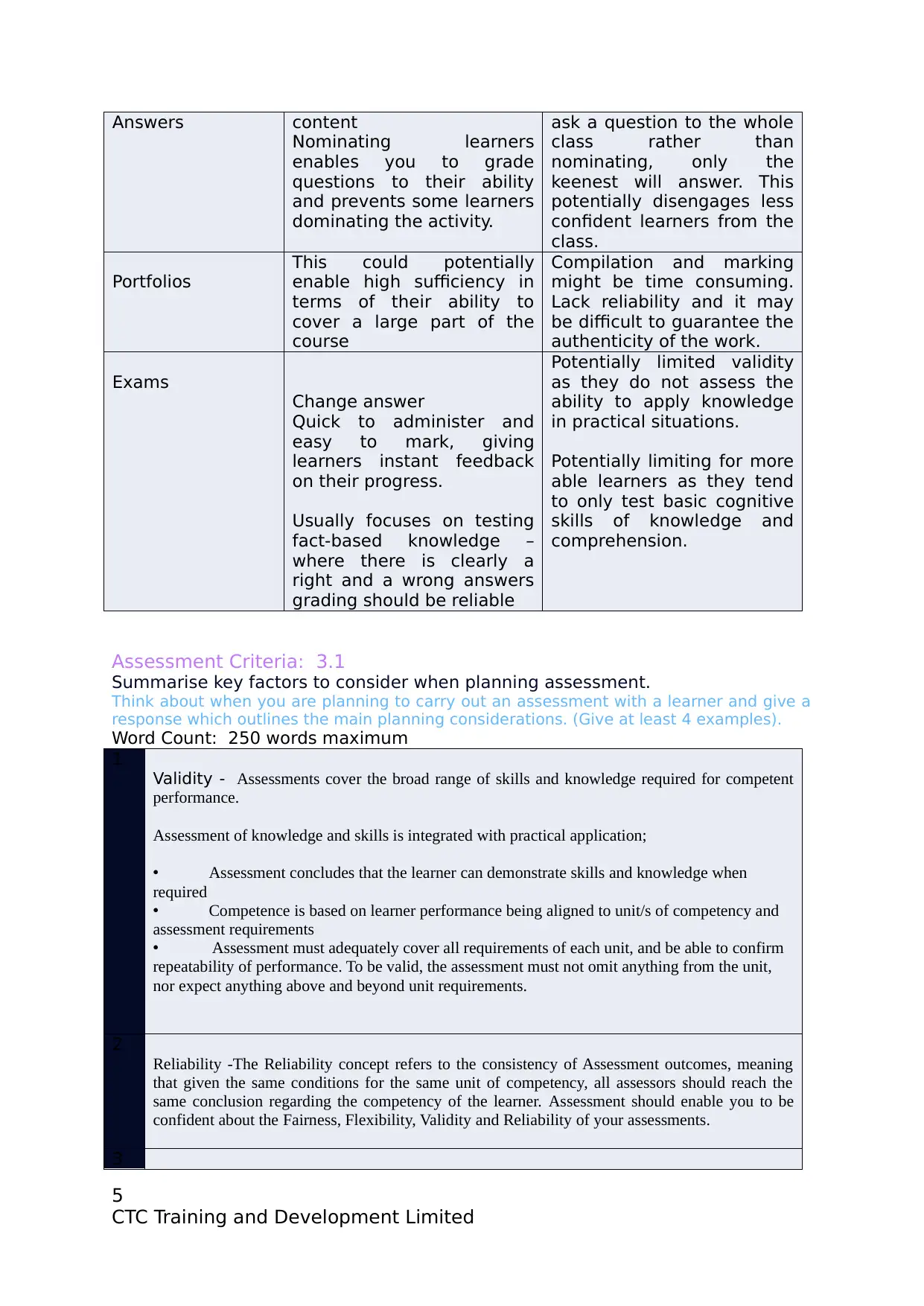
Answers content
Nominating learners
enables you to grade
questions to their ability
and prevents some learners
dominating the activity.
ask a question to the whole
class rather than
nominating, only the
keenest will answer. This
potentially disengages less
confident learners from the
class.
Portfolios
This could potentially
enable high sufficiency in
terms of their ability to
cover a large part of the
course
Compilation and marking
might be time consuming.
Lack reliability and it may
be difficult to guarantee the
authenticity of the work.
Exams
Change answer
Quick to administer and
easy to mark, giving
learners instant feedback
on their progress.
Usually focuses on testing
fact-based knowledge –
where there is clearly a
right and a wrong answers
grading should be reliable
Potentially limited validity
as they do not assess the
ability to apply knowledge
in practical situations.
Potentially limiting for more
able learners as they tend
to only test basic cognitive
skills of knowledge and
comprehension.
Assessment Criteria: 3.1
Summarise key factors to consider when planning assessment.
Think about when you are planning to carry out an assessment with a learner and give a
response which outlines the main planning considerations. (Give at least 4 examples).
Word Count: 250 words maximum
1
Validity - Assessments cover the broad range of skills and knowledge required for competent
performance.
Assessment of knowledge and skills is integrated with practical application;
• Assessment concludes that the learner can demonstrate skills and knowledge when
required
• Competence is based on learner performance being aligned to unit/s of competency and
assessment requirements
• Assessment must adequately cover all requirements of each unit, and be able to confirm
repeatability of performance. To be valid, the assessment must not omit anything from the unit,
nor expect anything above and beyond unit requirements.
2
Reliability -The Reliability concept refers to the consistency of Assessment outcomes, meaning
that given the same conditions for the same unit of competency, all assessors should reach the
same conclusion regarding the competency of the learner. Assessment should enable you to be
confident about the Fairness, Flexibility, Validity and Reliability of your assessments.
3
5
CTC Training and Development Limited
Nominating learners
enables you to grade
questions to their ability
and prevents some learners
dominating the activity.
ask a question to the whole
class rather than
nominating, only the
keenest will answer. This
potentially disengages less
confident learners from the
class.
Portfolios
This could potentially
enable high sufficiency in
terms of their ability to
cover a large part of the
course
Compilation and marking
might be time consuming.
Lack reliability and it may
be difficult to guarantee the
authenticity of the work.
Exams
Change answer
Quick to administer and
easy to mark, giving
learners instant feedback
on their progress.
Usually focuses on testing
fact-based knowledge –
where there is clearly a
right and a wrong answers
grading should be reliable
Potentially limited validity
as they do not assess the
ability to apply knowledge
in practical situations.
Potentially limiting for more
able learners as they tend
to only test basic cognitive
skills of knowledge and
comprehension.
Assessment Criteria: 3.1
Summarise key factors to consider when planning assessment.
Think about when you are planning to carry out an assessment with a learner and give a
response which outlines the main planning considerations. (Give at least 4 examples).
Word Count: 250 words maximum
1
Validity - Assessments cover the broad range of skills and knowledge required for competent
performance.
Assessment of knowledge and skills is integrated with practical application;
• Assessment concludes that the learner can demonstrate skills and knowledge when
required
• Competence is based on learner performance being aligned to unit/s of competency and
assessment requirements
• Assessment must adequately cover all requirements of each unit, and be able to confirm
repeatability of performance. To be valid, the assessment must not omit anything from the unit,
nor expect anything above and beyond unit requirements.
2
Reliability -The Reliability concept refers to the consistency of Assessment outcomes, meaning
that given the same conditions for the same unit of competency, all assessors should reach the
same conclusion regarding the competency of the learner. Assessment should enable you to be
confident about the Fairness, Flexibility, Validity and Reliability of your assessments.
3
5
CTC Training and Development Limited
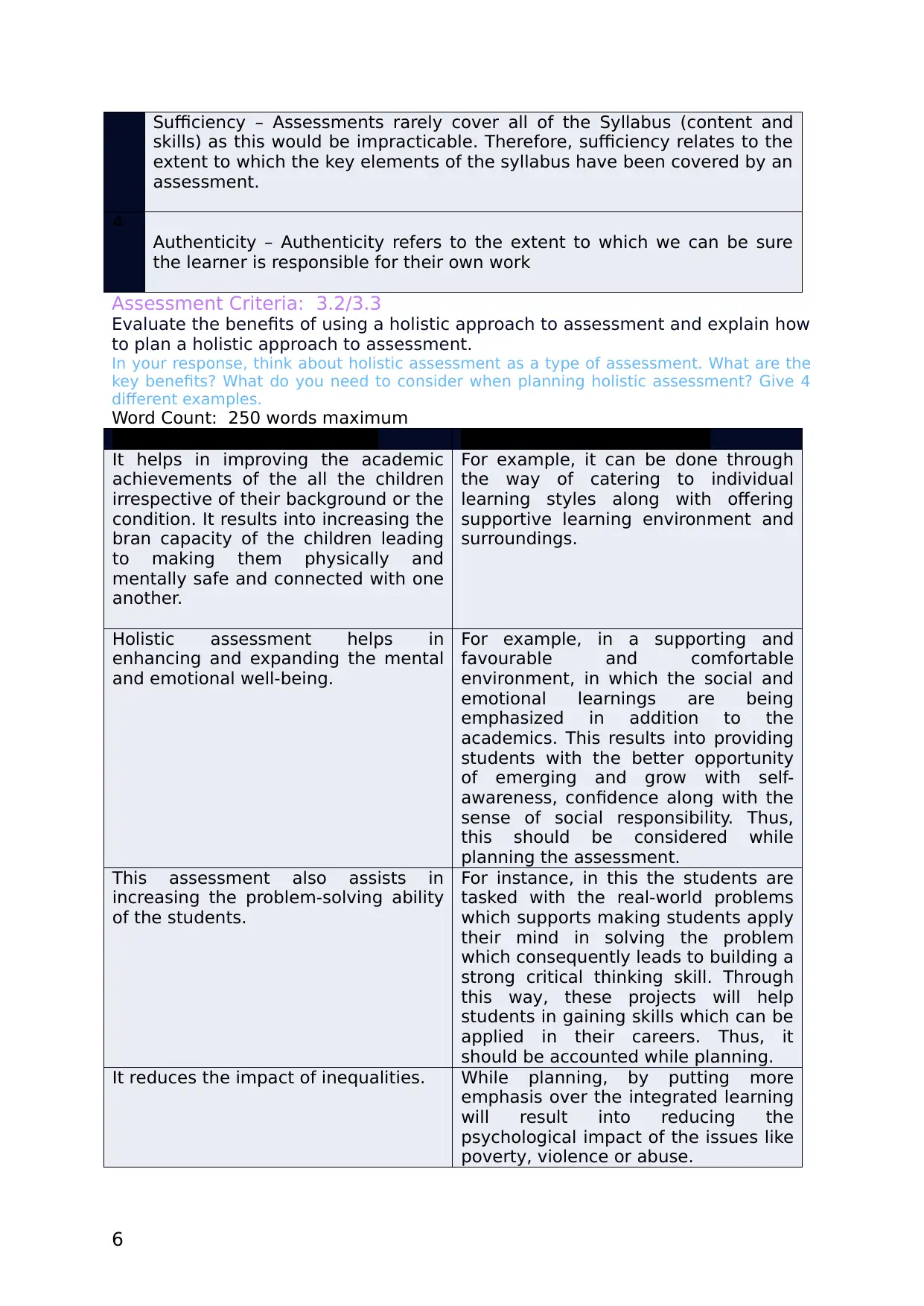
Sufficiency – Assessments rarely cover all of the Syllabus (content and
skills) as this would be impracticable. Therefore, sufficiency relates to the
extent to which the key elements of the syllabus have been covered by an
assessment.
4
Authenticity – Authenticity refers to the extent to which we can be sure
the learner is responsible for their own work
Assessment Criteria: 3.2/3.3
Evaluate the benefits of using a holistic approach to assessment and explain how
to plan a holistic approach to assessment.
In your response, think about holistic assessment as a type of assessment. What are the
key benefits? What do you need to consider when planning holistic assessment? Give 4
different examples.
Word Count: 250 words maximum
Benefits of Holistic assessment Consideration when planning
It helps in improving the academic
achievements of the all the children
irrespective of their background or the
condition. It results into increasing the
bran capacity of the children leading
to making them physically and
mentally safe and connected with one
another.
For example, it can be done through
the way of catering to individual
learning styles along with offering
supportive learning environment and
surroundings.
Holistic assessment helps in
enhancing and expanding the mental
and emotional well-being.
For example, in a supporting and
favourable and comfortable
environment, in which the social and
emotional learnings are being
emphasized in addition to the
academics. This results into providing
students with the better opportunity
of emerging and grow with self-
awareness, confidence along with the
sense of social responsibility. Thus,
this should be considered while
planning the assessment.
This assessment also assists in
increasing the problem-solving ability
of the students.
For instance, in this the students are
tasked with the real-world problems
which supports making students apply
their mind in solving the problem
which consequently leads to building a
strong critical thinking skill. Through
this way, these projects will help
students in gaining skills which can be
applied in their careers. Thus, it
should be accounted while planning.
It reduces the impact of inequalities. While planning, by putting more
emphasis over the integrated learning
will result into reducing the
psychological impact of the issues like
poverty, violence or abuse.
6
skills) as this would be impracticable. Therefore, sufficiency relates to the
extent to which the key elements of the syllabus have been covered by an
assessment.
4
Authenticity – Authenticity refers to the extent to which we can be sure
the learner is responsible for their own work
Assessment Criteria: 3.2/3.3
Evaluate the benefits of using a holistic approach to assessment and explain how
to plan a holistic approach to assessment.
In your response, think about holistic assessment as a type of assessment. What are the
key benefits? What do you need to consider when planning holistic assessment? Give 4
different examples.
Word Count: 250 words maximum
Benefits of Holistic assessment Consideration when planning
It helps in improving the academic
achievements of the all the children
irrespective of their background or the
condition. It results into increasing the
bran capacity of the children leading
to making them physically and
mentally safe and connected with one
another.
For example, it can be done through
the way of catering to individual
learning styles along with offering
supportive learning environment and
surroundings.
Holistic assessment helps in
enhancing and expanding the mental
and emotional well-being.
For example, in a supporting and
favourable and comfortable
environment, in which the social and
emotional learnings are being
emphasized in addition to the
academics. This results into providing
students with the better opportunity
of emerging and grow with self-
awareness, confidence along with the
sense of social responsibility. Thus,
this should be considered while
planning the assessment.
This assessment also assists in
increasing the problem-solving ability
of the students.
For instance, in this the students are
tasked with the real-world problems
which supports making students apply
their mind in solving the problem
which consequently leads to building a
strong critical thinking skill. Through
this way, these projects will help
students in gaining skills which can be
applied in their careers. Thus, it
should be accounted while planning.
It reduces the impact of inequalities. While planning, by putting more
emphasis over the integrated learning
will result into reducing the
psychological impact of the issues like
poverty, violence or abuse.
6
⊘ This is a preview!⊘
Do you want full access?
Subscribe today to unlock all pages.

Trusted by 1+ million students worldwide
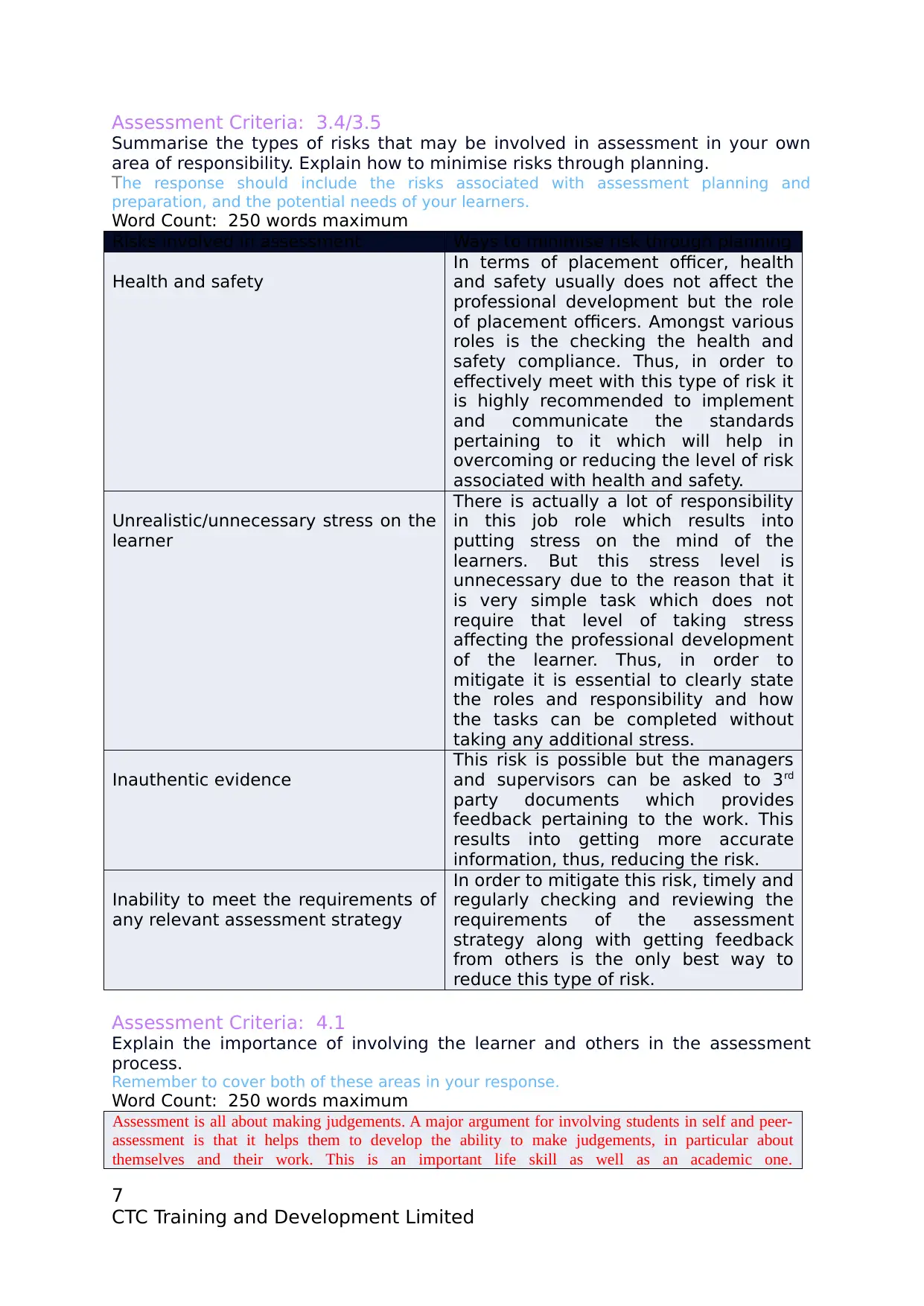
Assessment Criteria: 3.4/3.5
Summarise the types of risks that may be involved in assessment in your own
area of responsibility. Explain how to minimise risks through planning.
The response should include the risks associated with assessment planning and
preparation, and the potential needs of your learners.
Word Count: 250 words maximum
Risks involved in assessment Ways to minimise risk through planning
Health and safety
In terms of placement officer, health
and safety usually does not affect the
professional development but the role
of placement officers. Amongst various
roles is the checking the health and
safety compliance. Thus, in order to
effectively meet with this type of risk it
is highly recommended to implement
and communicate the standards
pertaining to it which will help in
overcoming or reducing the level of risk
associated with health and safety.
Unrealistic/unnecessary stress on the
learner
There is actually a lot of responsibility
in this job role which results into
putting stress on the mind of the
learners. But this stress level is
unnecessary due to the reason that it
is very simple task which does not
require that level of taking stress
affecting the professional development
of the learner. Thus, in order to
mitigate it is essential to clearly state
the roles and responsibility and how
the tasks can be completed without
taking any additional stress.
Inauthentic evidence
This risk is possible but the managers
and supervisors can be asked to 3rd
party documents which provides
feedback pertaining to the work. This
results into getting more accurate
information, thus, reducing the risk.
Inability to meet the requirements of
any relevant assessment strategy
In order to mitigate this risk, timely and
regularly checking and reviewing the
requirements of the assessment
strategy along with getting feedback
from others is the only best way to
reduce this type of risk.
Assessment Criteria: 4.1
Explain the importance of involving the learner and others in the assessment
process.
Remember to cover both of these areas in your response.
Word Count: 250 words maximum
Assessment is all about making judgements. A major argument for involving students in self and peer-
assessment is that it helps them to develop the ability to make judgements, in particular about
themselves and their work. This is an important life skill as well as an academic one.
7
CTC Training and Development Limited
Summarise the types of risks that may be involved in assessment in your own
area of responsibility. Explain how to minimise risks through planning.
The response should include the risks associated with assessment planning and
preparation, and the potential needs of your learners.
Word Count: 250 words maximum
Risks involved in assessment Ways to minimise risk through planning
Health and safety
In terms of placement officer, health
and safety usually does not affect the
professional development but the role
of placement officers. Amongst various
roles is the checking the health and
safety compliance. Thus, in order to
effectively meet with this type of risk it
is highly recommended to implement
and communicate the standards
pertaining to it which will help in
overcoming or reducing the level of risk
associated with health and safety.
Unrealistic/unnecessary stress on the
learner
There is actually a lot of responsibility
in this job role which results into
putting stress on the mind of the
learners. But this stress level is
unnecessary due to the reason that it
is very simple task which does not
require that level of taking stress
affecting the professional development
of the learner. Thus, in order to
mitigate it is essential to clearly state
the roles and responsibility and how
the tasks can be completed without
taking any additional stress.
Inauthentic evidence
This risk is possible but the managers
and supervisors can be asked to 3rd
party documents which provides
feedback pertaining to the work. This
results into getting more accurate
information, thus, reducing the risk.
Inability to meet the requirements of
any relevant assessment strategy
In order to mitigate this risk, timely and
regularly checking and reviewing the
requirements of the assessment
strategy along with getting feedback
from others is the only best way to
reduce this type of risk.
Assessment Criteria: 4.1
Explain the importance of involving the learner and others in the assessment
process.
Remember to cover both of these areas in your response.
Word Count: 250 words maximum
Assessment is all about making judgements. A major argument for involving students in self and peer-
assessment is that it helps them to develop the ability to make judgements, in particular about
themselves and their work. This is an important life skill as well as an academic one.
7
CTC Training and Development Limited
Paraphrase This Document
Need a fresh take? Get an instant paraphrase of this document with our AI Paraphraser
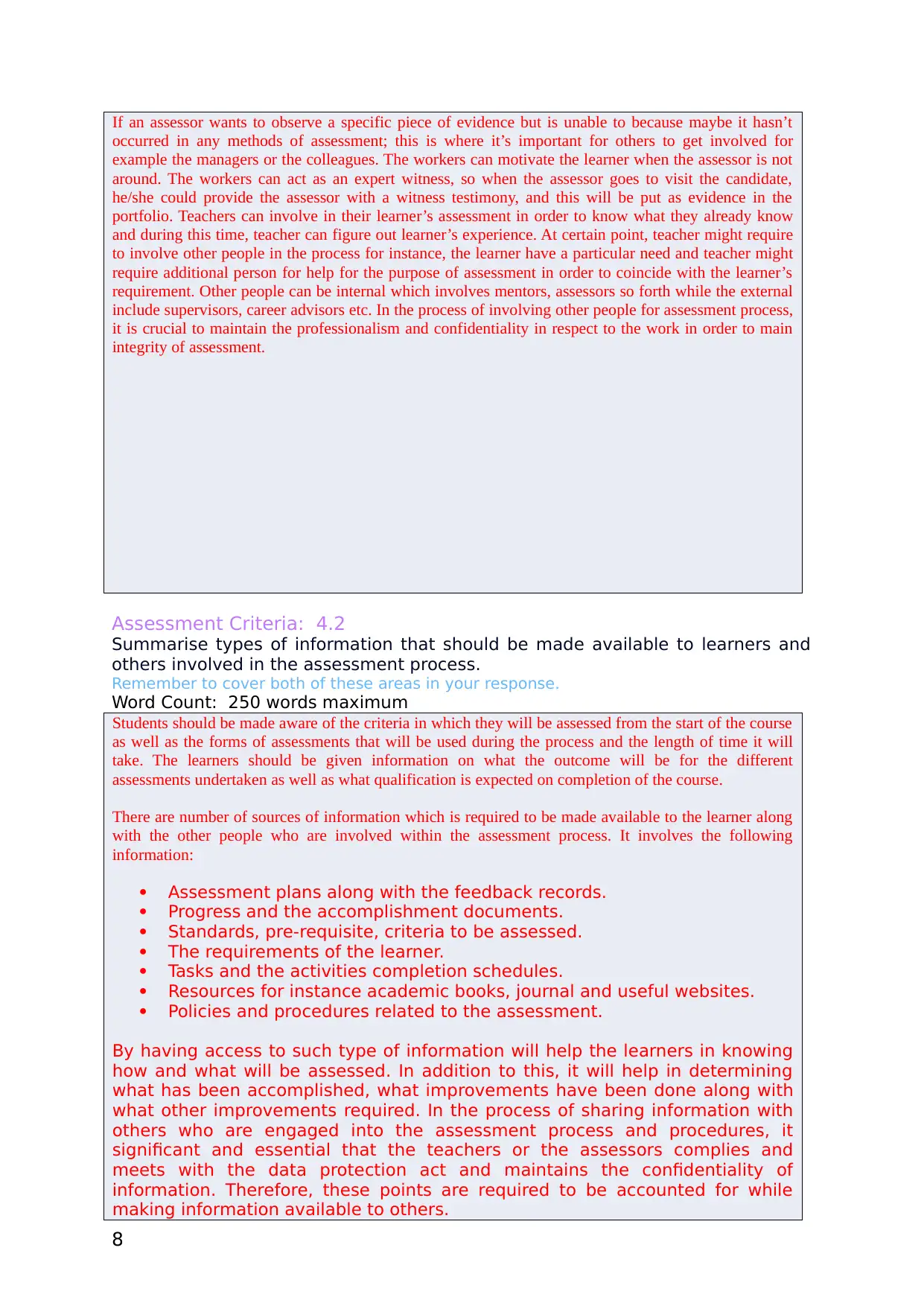
If an assessor wants to observe a specific piece of evidence but is unable to because maybe it hasn’t
occurred in any methods of assessment; this is where it’s important for others to get involved for
example the managers or the colleagues. The workers can motivate the learner when the assessor is not
around. The workers can act as an expert witness, so when the assessor goes to visit the candidate,
he/she could provide the assessor with a witness testimony, and this will be put as evidence in the
portfolio. Teachers can involve in their learner’s assessment in order to know what they already know
and during this time, teacher can figure out learner’s experience. At certain point, teacher might require
to involve other people in the process for instance, the learner have a particular need and teacher might
require additional person for help for the purpose of assessment in order to coincide with the learner’s
requirement. Other people can be internal which involves mentors, assessors so forth while the external
include supervisors, career advisors etc. In the process of involving other people for assessment process,
it is crucial to maintain the professionalism and confidentiality in respect to the work in order to main
integrity of assessment.
Assessment Criteria: 4.2
Summarise types of information that should be made available to learners and
others involved in the assessment process.
Remember to cover both of these areas in your response.
Word Count: 250 words maximum
Students should be made aware of the criteria in which they will be assessed from the start of the course
as well as the forms of assessments that will be used during the process and the length of time it will
take. The learners should be given information on what the outcome will be for the different
assessments undertaken as well as what qualification is expected on completion of the course.
There are number of sources of information which is required to be made available to the learner along
with the other people who are involved within the assessment process. It involves the following
information:
Assessment plans along with the feedback records.
Progress and the accomplishment documents.
Standards, pre-requisite, criteria to be assessed.
The requirements of the learner.
Tasks and the activities completion schedules.
Resources for instance academic books, journal and useful websites.
Policies and procedures related to the assessment.
By having access to such type of information will help the learners in knowing
how and what will be assessed. In addition to this, it will help in determining
what has been accomplished, what improvements have been done along with
what other improvements required. In the process of sharing information with
others who are engaged into the assessment process and procedures, it
significant and essential that the teachers or the assessors complies and
meets with the data protection act and maintains the confidentiality of
information. Therefore, these points are required to be accounted for while
making information available to others.
8
occurred in any methods of assessment; this is where it’s important for others to get involved for
example the managers or the colleagues. The workers can motivate the learner when the assessor is not
around. The workers can act as an expert witness, so when the assessor goes to visit the candidate,
he/she could provide the assessor with a witness testimony, and this will be put as evidence in the
portfolio. Teachers can involve in their learner’s assessment in order to know what they already know
and during this time, teacher can figure out learner’s experience. At certain point, teacher might require
to involve other people in the process for instance, the learner have a particular need and teacher might
require additional person for help for the purpose of assessment in order to coincide with the learner’s
requirement. Other people can be internal which involves mentors, assessors so forth while the external
include supervisors, career advisors etc. In the process of involving other people for assessment process,
it is crucial to maintain the professionalism and confidentiality in respect to the work in order to main
integrity of assessment.
Assessment Criteria: 4.2
Summarise types of information that should be made available to learners and
others involved in the assessment process.
Remember to cover both of these areas in your response.
Word Count: 250 words maximum
Students should be made aware of the criteria in which they will be assessed from the start of the course
as well as the forms of assessments that will be used during the process and the length of time it will
take. The learners should be given information on what the outcome will be for the different
assessments undertaken as well as what qualification is expected on completion of the course.
There are number of sources of information which is required to be made available to the learner along
with the other people who are involved within the assessment process. It involves the following
information:
Assessment plans along with the feedback records.
Progress and the accomplishment documents.
Standards, pre-requisite, criteria to be assessed.
The requirements of the learner.
Tasks and the activities completion schedules.
Resources for instance academic books, journal and useful websites.
Policies and procedures related to the assessment.
By having access to such type of information will help the learners in knowing
how and what will be assessed. In addition to this, it will help in determining
what has been accomplished, what improvements have been done along with
what other improvements required. In the process of sharing information with
others who are engaged into the assessment process and procedures, it
significant and essential that the teachers or the assessors complies and
meets with the data protection act and maintains the confidentiality of
information. Therefore, these points are required to be accounted for while
making information available to others.
8
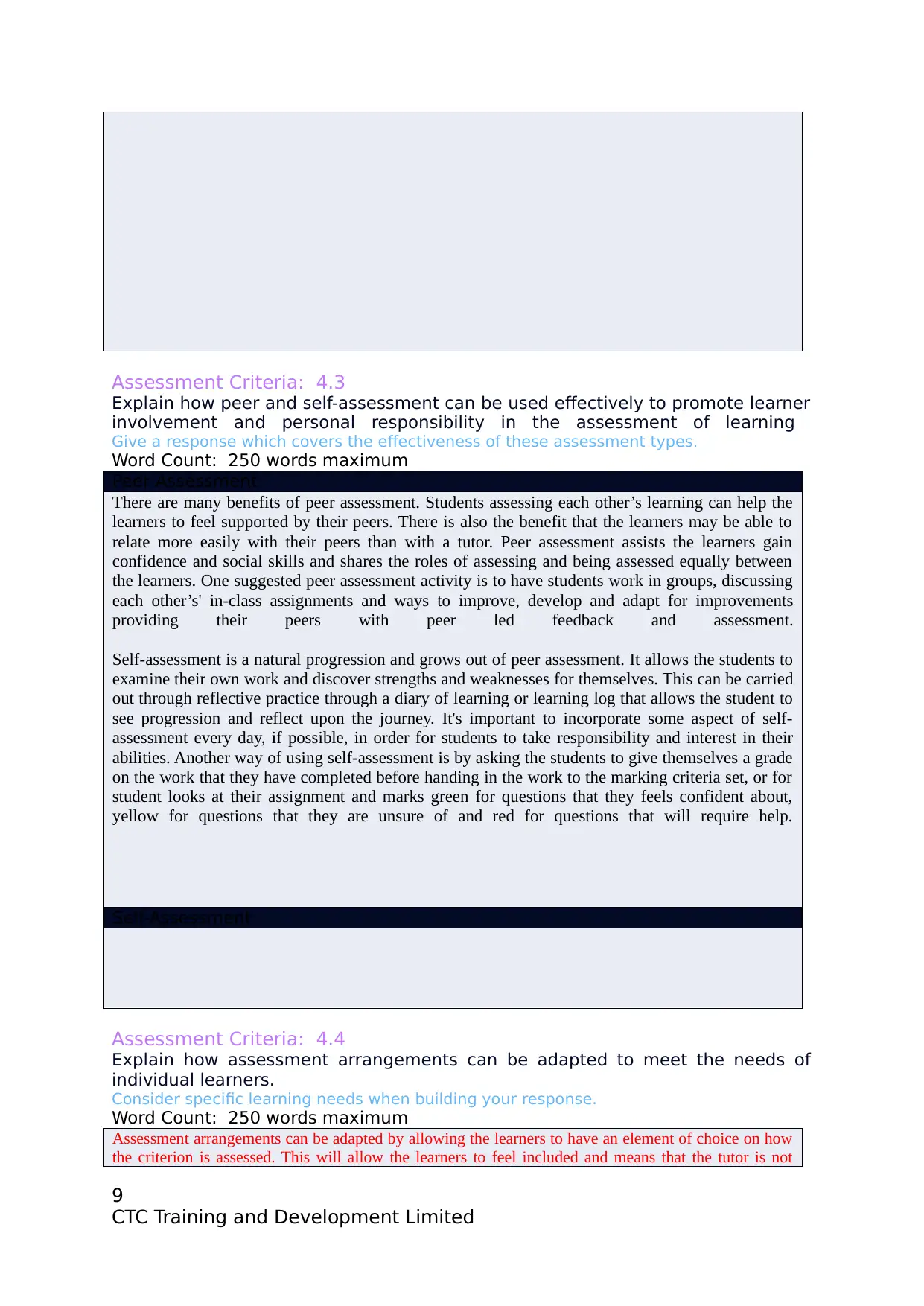
Assessment Criteria: 4.3
Explain how peer and self-assessment can be used effectively to promote learner
involvement and personal responsibility in the assessment of learning
Give a response which covers the effectiveness of these assessment types.
Word Count: 250 words maximum
Peer Assessment
There are many benefits of peer assessment. Students assessing each other’s learning can help the
learners to feel supported by their peers. There is also the benefit that the learners may be able to
relate more easily with their peers than with a tutor. Peer assessment assists the learners gain
confidence and social skills and shares the roles of assessing and being assessed equally between
the learners. One suggested peer assessment activity is to have students work in groups, discussing
each other’s' in-class assignments and ways to improve, develop and adapt for improvements
providing their peers with peer led feedback and assessment.
Self-assessment is a natural progression and grows out of peer assessment. It allows the students to
examine their own work and discover strengths and weaknesses for themselves. This can be carried
out through reflective practice through a diary of learning or learning log that allows the student to
see progression and reflect upon the journey. It's important to incorporate some aspect of self-
assessment every day, if possible, in order for students to take responsibility and interest in their
abilities. Another way of using self-assessment is by asking the students to give themselves a grade
on the work that they have completed before handing in the work to the marking criteria set, or for
student looks at their assignment and marks green for questions that they feels confident about,
yellow for questions that they are unsure of and red for questions that will require help.
Self-Assessment
Assessment Criteria: 4.4
Explain how assessment arrangements can be adapted to meet the needs of
individual learners.
Consider specific learning needs when building your response.
Word Count: 250 words maximum
Assessment arrangements can be adapted by allowing the learners to have an element of choice on how
the criterion is assessed. This will allow the learners to feel included and means that the tutor is not
9
CTC Training and Development Limited
Explain how peer and self-assessment can be used effectively to promote learner
involvement and personal responsibility in the assessment of learning
Give a response which covers the effectiveness of these assessment types.
Word Count: 250 words maximum
Peer Assessment
There are many benefits of peer assessment. Students assessing each other’s learning can help the
learners to feel supported by their peers. There is also the benefit that the learners may be able to
relate more easily with their peers than with a tutor. Peer assessment assists the learners gain
confidence and social skills and shares the roles of assessing and being assessed equally between
the learners. One suggested peer assessment activity is to have students work in groups, discussing
each other’s' in-class assignments and ways to improve, develop and adapt for improvements
providing their peers with peer led feedback and assessment.
Self-assessment is a natural progression and grows out of peer assessment. It allows the students to
examine their own work and discover strengths and weaknesses for themselves. This can be carried
out through reflective practice through a diary of learning or learning log that allows the student to
see progression and reflect upon the journey. It's important to incorporate some aspect of self-
assessment every day, if possible, in order for students to take responsibility and interest in their
abilities. Another way of using self-assessment is by asking the students to give themselves a grade
on the work that they have completed before handing in the work to the marking criteria set, or for
student looks at their assignment and marks green for questions that they feels confident about,
yellow for questions that they are unsure of and red for questions that will require help.
Self-Assessment
Assessment Criteria: 4.4
Explain how assessment arrangements can be adapted to meet the needs of
individual learners.
Consider specific learning needs when building your response.
Word Count: 250 words maximum
Assessment arrangements can be adapted by allowing the learners to have an element of choice on how
the criterion is assessed. This will allow the learners to feel included and means that the tutor is not
9
CTC Training and Development Limited
⊘ This is a preview!⊘
Do you want full access?
Subscribe today to unlock all pages.

Trusted by 1+ million students worldwide
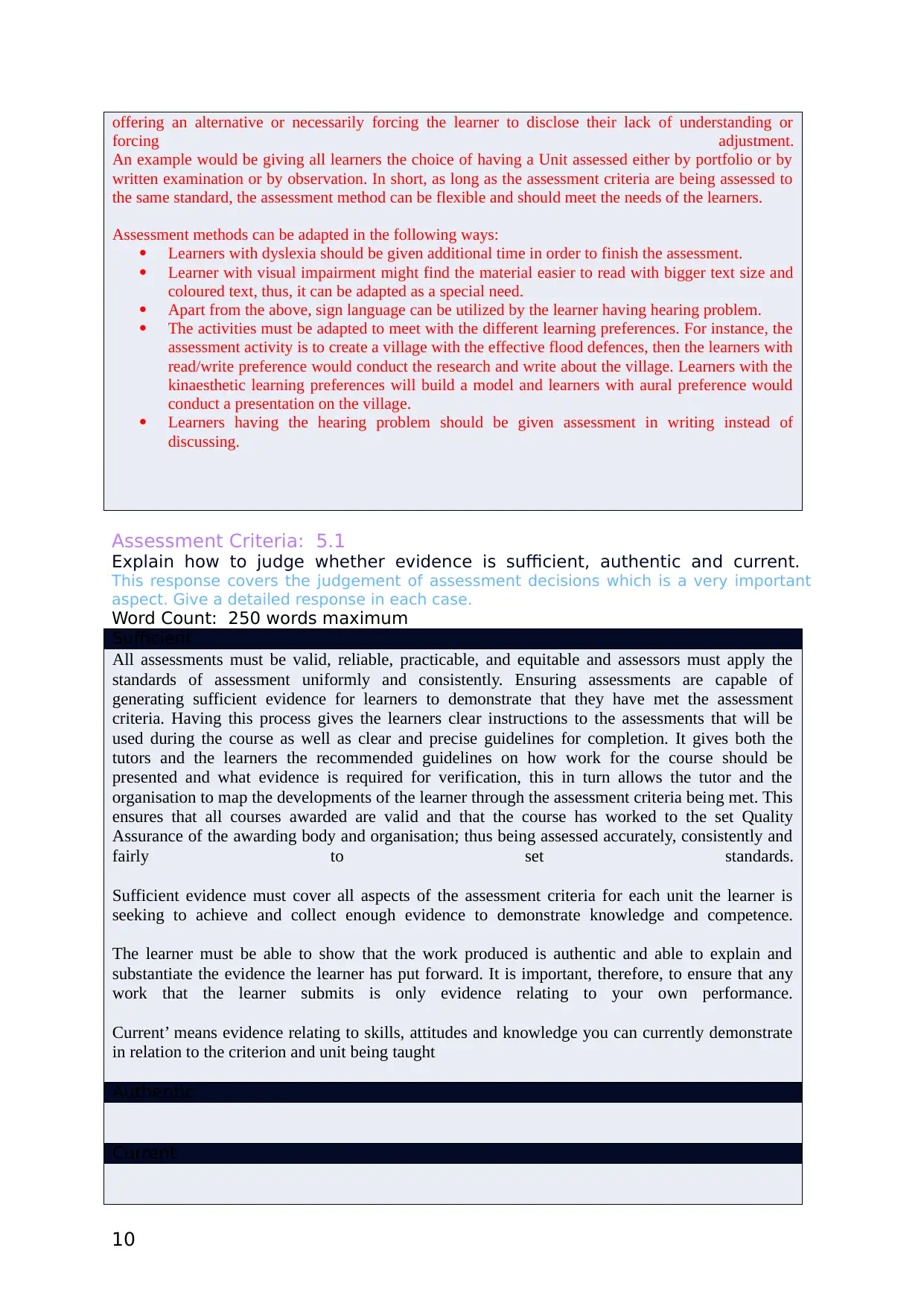
offering an alternative or necessarily forcing the learner to disclose their lack of understanding or
forcing adjustment.
An example would be giving all learners the choice of having a Unit assessed either by portfolio or by
written examination or by observation. In short, as long as the assessment criteria are being assessed to
the same standard, the assessment method can be flexible and should meet the needs of the learners.
Assessment methods can be adapted in the following ways:
Learners with dyslexia should be given additional time in order to finish the assessment.
Learner with visual impairment might find the material easier to read with bigger text size and
coloured text, thus, it can be adapted as a special need.
Apart from the above, sign language can be utilized by the learner having hearing problem.
The activities must be adapted to meet with the different learning preferences. For instance, the
assessment activity is to create a village with the effective flood defences, then the learners with
read/write preference would conduct the research and write about the village. Learners with the
kinaesthetic learning preferences will build a model and learners with aural preference would
conduct a presentation on the village.
Learners having the hearing problem should be given assessment in writing instead of
discussing.
Assessment Criteria: 5.1
Explain how to judge whether evidence is sufficient, authentic and current.
This response covers the judgement of assessment decisions which is a very important
aspect. Give a detailed response in each case.
Word Count: 250 words maximum
Sufficient
All assessments must be valid, reliable, practicable, and equitable and assessors must apply the
standards of assessment uniformly and consistently. Ensuring assessments are capable of
generating sufficient evidence for learners to demonstrate that they have met the assessment
criteria. Having this process gives the learners clear instructions to the assessments that will be
used during the course as well as clear and precise guidelines for completion. It gives both the
tutors and the learners the recommended guidelines on how work for the course should be
presented and what evidence is required for verification, this in turn allows the tutor and the
organisation to map the developments of the learner through the assessment criteria being met. This
ensures that all courses awarded are valid and that the course has worked to the set Quality
Assurance of the awarding body and organisation; thus being assessed accurately, consistently and
fairly to set standards.
Sufficient evidence must cover all aspects of the assessment criteria for each unit the learner is
seeking to achieve and collect enough evidence to demonstrate knowledge and competence.
The learner must be able to show that the work produced is authentic and able to explain and
substantiate the evidence the learner has put forward. It is important, therefore, to ensure that any
work that the learner submits is only evidence relating to your own performance.
Current’ means evidence relating to skills, attitudes and knowledge you can currently demonstrate
in relation to the criterion and unit being taught
Authentic
Current
10
forcing adjustment.
An example would be giving all learners the choice of having a Unit assessed either by portfolio or by
written examination or by observation. In short, as long as the assessment criteria are being assessed to
the same standard, the assessment method can be flexible and should meet the needs of the learners.
Assessment methods can be adapted in the following ways:
Learners with dyslexia should be given additional time in order to finish the assessment.
Learner with visual impairment might find the material easier to read with bigger text size and
coloured text, thus, it can be adapted as a special need.
Apart from the above, sign language can be utilized by the learner having hearing problem.
The activities must be adapted to meet with the different learning preferences. For instance, the
assessment activity is to create a village with the effective flood defences, then the learners with
read/write preference would conduct the research and write about the village. Learners with the
kinaesthetic learning preferences will build a model and learners with aural preference would
conduct a presentation on the village.
Learners having the hearing problem should be given assessment in writing instead of
discussing.
Assessment Criteria: 5.1
Explain how to judge whether evidence is sufficient, authentic and current.
This response covers the judgement of assessment decisions which is a very important
aspect. Give a detailed response in each case.
Word Count: 250 words maximum
Sufficient
All assessments must be valid, reliable, practicable, and equitable and assessors must apply the
standards of assessment uniformly and consistently. Ensuring assessments are capable of
generating sufficient evidence for learners to demonstrate that they have met the assessment
criteria. Having this process gives the learners clear instructions to the assessments that will be
used during the course as well as clear and precise guidelines for completion. It gives both the
tutors and the learners the recommended guidelines on how work for the course should be
presented and what evidence is required for verification, this in turn allows the tutor and the
organisation to map the developments of the learner through the assessment criteria being met. This
ensures that all courses awarded are valid and that the course has worked to the set Quality
Assurance of the awarding body and organisation; thus being assessed accurately, consistently and
fairly to set standards.
Sufficient evidence must cover all aspects of the assessment criteria for each unit the learner is
seeking to achieve and collect enough evidence to demonstrate knowledge and competence.
The learner must be able to show that the work produced is authentic and able to explain and
substantiate the evidence the learner has put forward. It is important, therefore, to ensure that any
work that the learner submits is only evidence relating to your own performance.
Current’ means evidence relating to skills, attitudes and knowledge you can currently demonstrate
in relation to the criterion and unit being taught
Authentic
Current
10
Paraphrase This Document
Need a fresh take? Get an instant paraphrase of this document with our AI Paraphraser

Assessment Criteria: 5.2
Explain how to ensure that assessment decisions are made against specified
criteria, valid, reliable and fair.
This response covers the judgement of assessment decisions which is a very important
aspect.
Word Count: 250 words maximum
Made against specified criteria
The assessor should follow as far as possible the criteria set down in the relevant unit and qualification.
All qualifications go through a standardisation process that enables each assessor to consistently make
valid decisions; that all assessors make the same decision on the same evidence base and all candidates
are assessed fairly. All corresponding evidence from the learner should be reliable in that they have
concrete knowledge and skill to back up their evidence. The evidence should be fair in that any leaner
will have the same opportunity to complete the assignment. It is crucial to make sure that all the
assessment criteria is related to the awarding body’s specifications.
Valid
To gain validity the assessor requires to make sure that the same outcome is
derived irrespective of the fact who is assessing the assessment. To this end,
criteria is an instruction pertaining to how to accomplish the task or goal must
be clear and achievable while undertaking the assessment related decisions.
Reliable
The assessor should find the benchmark or the standard which will help in
accurately measuring the performance of the learners which has been agreed
within the internal verification process which suits the situation.
Fair
Equality and fairness standard or criteria required to be followed which
involves allowing same treatment to all the learners excluding specific
requirement students. It includes providing additional time, alternative method
for learning of the learners as per the situation or on the basis of the need
determined in the group profile.
Assessment Criteria: 6.1
Evaluate the importance of quality assurance in the assessment process
To evaluate you must look at the potential limitations as well as the benefits.
Word Count: 250 words maximum
11
CTC Training and Development Limited
Explain how to ensure that assessment decisions are made against specified
criteria, valid, reliable and fair.
This response covers the judgement of assessment decisions which is a very important
aspect.
Word Count: 250 words maximum
Made against specified criteria
The assessor should follow as far as possible the criteria set down in the relevant unit and qualification.
All qualifications go through a standardisation process that enables each assessor to consistently make
valid decisions; that all assessors make the same decision on the same evidence base and all candidates
are assessed fairly. All corresponding evidence from the learner should be reliable in that they have
concrete knowledge and skill to back up their evidence. The evidence should be fair in that any leaner
will have the same opportunity to complete the assignment. It is crucial to make sure that all the
assessment criteria is related to the awarding body’s specifications.
Valid
To gain validity the assessor requires to make sure that the same outcome is
derived irrespective of the fact who is assessing the assessment. To this end,
criteria is an instruction pertaining to how to accomplish the task or goal must
be clear and achievable while undertaking the assessment related decisions.
Reliable
The assessor should find the benchmark or the standard which will help in
accurately measuring the performance of the learners which has been agreed
within the internal verification process which suits the situation.
Fair
Equality and fairness standard or criteria required to be followed which
involves allowing same treatment to all the learners excluding specific
requirement students. It includes providing additional time, alternative method
for learning of the learners as per the situation or on the basis of the need
determined in the group profile.
Assessment Criteria: 6.1
Evaluate the importance of quality assurance in the assessment process
To evaluate you must look at the potential limitations as well as the benefits.
Word Count: 250 words maximum
11
CTC Training and Development Limited
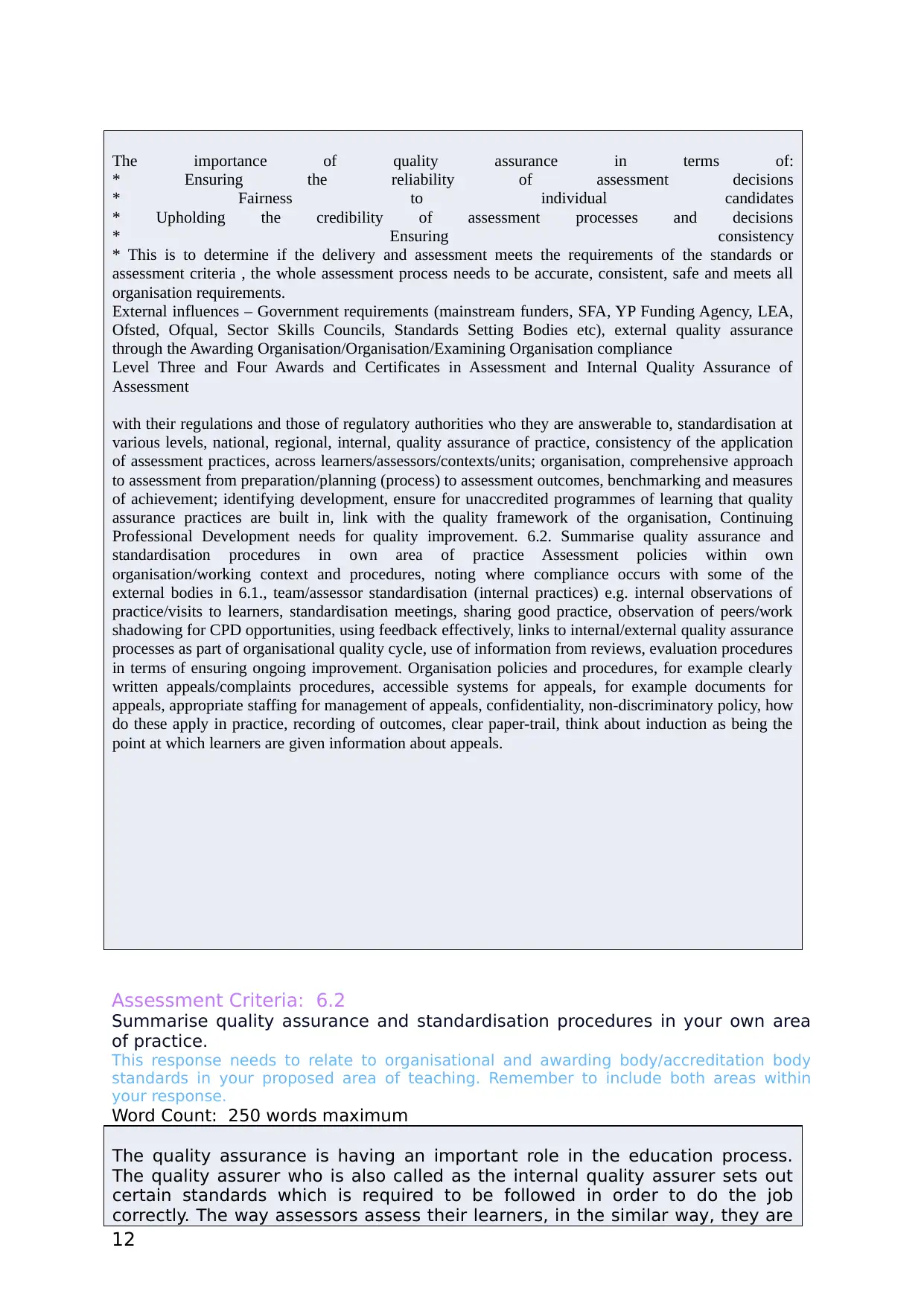
The importance of quality assurance in terms of:
* Ensuring the reliability of assessment decisions
* Fairness to individual candidates
* Upholding the credibility of assessment processes and decisions
* Ensuring consistency
* This is to determine if the delivery and assessment meets the requirements of the standards or
assessment criteria , the whole assessment process needs to be accurate, consistent, safe and meets all
organisation requirements.
External influences – Government requirements (mainstream funders, SFA, YP Funding Agency, LEA,
Ofsted, Ofqual, Sector Skills Councils, Standards Setting Bodies etc), external quality assurance
through the Awarding Organisation/Organisation/Examining Organisation compliance
Level Three and Four Awards and Certificates in Assessment and Internal Quality Assurance of
Assessment
with their regulations and those of regulatory authorities who they are answerable to, standardisation at
various levels, national, regional, internal, quality assurance of practice, consistency of the application
of assessment practices, across learners/assessors/contexts/units; organisation, comprehensive approach
to assessment from preparation/planning (process) to assessment outcomes, benchmarking and measures
of achievement; identifying development, ensure for unaccredited programmes of learning that quality
assurance practices are built in, link with the quality framework of the organisation, Continuing
Professional Development needs for quality improvement. 6.2. Summarise quality assurance and
standardisation procedures in own area of practice Assessment policies within own
organisation/working context and procedures, noting where compliance occurs with some of the
external bodies in 6.1., team/assessor standardisation (internal practices) e.g. internal observations of
practice/visits to learners, standardisation meetings, sharing good practice, observation of peers/work
shadowing for CPD opportunities, using feedback effectively, links to internal/external quality assurance
processes as part of organisational quality cycle, use of information from reviews, evaluation procedures
in terms of ensuring ongoing improvement. Organisation policies and procedures, for example clearly
written appeals/complaints procedures, accessible systems for appeals, for example documents for
appeals, appropriate staffing for management of appeals, confidentiality, non-discriminatory policy, how
do these apply in practice, recording of outcomes, clear paper-trail, think about induction as being the
point at which learners are given information about appeals.
Assessment Criteria: 6.2
Summarise quality assurance and standardisation procedures in your own area
of practice.
This response needs to relate to organisational and awarding body/accreditation body
standards in your proposed area of teaching. Remember to include both areas within
your response.
Word Count: 250 words maximum
The quality assurance is having an important role in the education process.
The quality assurer who is also called as the internal quality assurer sets out
certain standards which is required to be followed in order to do the job
correctly. The way assessors assess their learners, in the similar way, they are
12
* Ensuring the reliability of assessment decisions
* Fairness to individual candidates
* Upholding the credibility of assessment processes and decisions
* Ensuring consistency
* This is to determine if the delivery and assessment meets the requirements of the standards or
assessment criteria , the whole assessment process needs to be accurate, consistent, safe and meets all
organisation requirements.
External influences – Government requirements (mainstream funders, SFA, YP Funding Agency, LEA,
Ofsted, Ofqual, Sector Skills Councils, Standards Setting Bodies etc), external quality assurance
through the Awarding Organisation/Organisation/Examining Organisation compliance
Level Three and Four Awards and Certificates in Assessment and Internal Quality Assurance of
Assessment
with their regulations and those of regulatory authorities who they are answerable to, standardisation at
various levels, national, regional, internal, quality assurance of practice, consistency of the application
of assessment practices, across learners/assessors/contexts/units; organisation, comprehensive approach
to assessment from preparation/planning (process) to assessment outcomes, benchmarking and measures
of achievement; identifying development, ensure for unaccredited programmes of learning that quality
assurance practices are built in, link with the quality framework of the organisation, Continuing
Professional Development needs for quality improvement. 6.2. Summarise quality assurance and
standardisation procedures in own area of practice Assessment policies within own
organisation/working context and procedures, noting where compliance occurs with some of the
external bodies in 6.1., team/assessor standardisation (internal practices) e.g. internal observations of
practice/visits to learners, standardisation meetings, sharing good practice, observation of peers/work
shadowing for CPD opportunities, using feedback effectively, links to internal/external quality assurance
processes as part of organisational quality cycle, use of information from reviews, evaluation procedures
in terms of ensuring ongoing improvement. Organisation policies and procedures, for example clearly
written appeals/complaints procedures, accessible systems for appeals, for example documents for
appeals, appropriate staffing for management of appeals, confidentiality, non-discriminatory policy, how
do these apply in practice, recording of outcomes, clear paper-trail, think about induction as being the
point at which learners are given information about appeals.
Assessment Criteria: 6.2
Summarise quality assurance and standardisation procedures in your own area
of practice.
This response needs to relate to organisational and awarding body/accreditation body
standards in your proposed area of teaching. Remember to include both areas within
your response.
Word Count: 250 words maximum
The quality assurance is having an important role in the education process.
The quality assurer who is also called as the internal quality assurer sets out
certain standards which is required to be followed in order to do the job
correctly. The way assessors assess their learners, in the similar way, they are
12
⊘ This is a preview!⊘
Do you want full access?
Subscribe today to unlock all pages.

Trusted by 1+ million students worldwide
1 out of 19